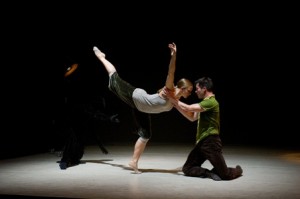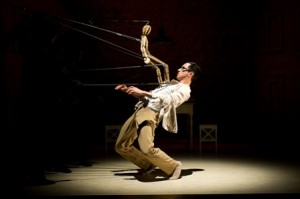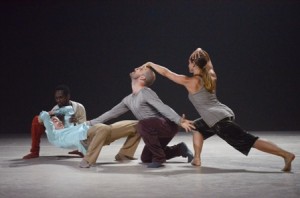
Cindy Salgado and Yannick Matthon of Kidd Pivot Frankfurt RM in 'Dark Matters' (photo Christopher Duggan/courtesy Jacob's Pillow)
JACOB’s PILLOW DANCE FESTIVAL
KIDD PIVOT
Doris Duke Theatre
July 7, 2011
Review by Anna Rogovoy
(BECKET, Mass.) – In a pre-performance talk, Jacob’s Pillow Scholar-in-Residence Philip Szporer quoted Kidd Pivot Frankfurt RM (Kidd Pivot) artistic director Crystal Pite as saying that she “need[s] to think of [her] role in this creation as disturber,” and the sentiment of this statement rings true when the clamor has subsided at the end of Dark Matters, the Canadian/German company’s evening-length presentation which continues its run at the Pillow through Sunday. Pite has disturbed the waters of contemporary dance, instigating a close examination of the role this movement form does — or should — play in the greater art world and in society at large.
Dark Matters opens with a spotlight creeping onto the stage, sliding up and down a set of panels that establish a room onstage. A dancer swathed in a black velvet jumpsuit slips out from behind one such panel, flicks on a stereo, and disappears again as a resonant voice (Christopher Gaze) intones lines from Voltaire’s Poem on the Lisbon Disaster and a second black-clad dancer slides along the floor like a snake. These sneaking figures evoke a sense of spying on something forbidden, something occult. In the semi-darkness, one of them guides a man (Peter Chu) dressed in tan slacks and beige shirt to a table, where he sits and begins to work. In a series of brief vignettes separated by the raising and lowering of light (which throughout the piece is impeccably designed by Robert Sondergaard), Chu constructs a puppet out of cardboard.

Peter Chu of Kidd Pivot Frankfurt RM in 'Dark Matters' (photo Christopher Duggan/courtesy Jacob's Pillow)
When the puppet is completed, dancers (each in a black velvet jumpsuit with black gloves, socks, and masks) affix poles to its appendages and manipulate it in a series of duets with Chu. They begin tenderly: the puppet walks along his creator’s body as Chu shifts to provide dynamic planes for it to move on. But they grow increasingly violent as the puppet becomes more demanding and more physically independent. Finally they come to blows in an armed duet: Chu with a cardboard axe, the puppet with a fatal pair of scissors. We don’t for a moment doubt that this paper marionette could — and does — end the life of his maker.
Throughout the first half of Dark Matters, the focus has been primarily on the narrative of the work, particularly as aided by the visual elements of this production. After the death of the puppet-maker, these elements literally come crashing down as the dancers in black topple the panels and a row of lights drops to lurch threateningly over the stage. One black figure surveys the wreckage, pulling a limp Chu to his feet and manipulating him until he can move on his own.
It’s all very effective. The Voltaire text addresses the theme without lecturing on it, the set and props clearly establish a world that remains abstract, and the scarcity of actual “dancing” makes the moments in which it does occur all the more satisfying. Pite has hooked us completely. So when we return after intermission to find that the stage has been cleared (save for one prone body) and discover almost immediately upon the commencement of the second half that it is much more focused on actual, physical movement, the question arises: does Pite say as much with her pure dance as she does with her more theatrically augmented work?
The answer is unequivocally yes. In the hour (which could just as easily have been twenty minutes or three hours) that follows, five dancers in pedestrian-inspired clothing and one still encased in black execute a series of phenomenal solos, duets, trios, and group sections. The partnering, rarely sentimental, is astonishing. Each dancer is tremendously gifted in his or her own facility, and combined they become twice more than the sum of their parts; just as a single movement ripples sensually through dancer Cindy Salgado’s body, so does it continue through her partner, Yannick Matthon. The performers act upon each other as forces of natural energy in intensely physical sequences.
Throughout this spellbinding dance-dream, the lone figure in black plays a variety of different roles. She (by process of elimination we ascertain that she is Sandra Marín Garcia) precipitates and supports movement, rearranging and reinforcing the other performers. She imbues them with fluid energy, sometimes without any physical contact. At times she joins in their ensemble sections as if she were one of them, and for the moment she is. She floats out from upstage where, recalling lighting artist Jennifer Tipton’s design for Twyla Tharp’s In the Upper Room, haze has made the back wall drop away; later she crawls unnoticed past the feet of the audience members in the front row, rising all of a sudden and emerging as if from our ranks. What exactly she represents is not made explicitly clear, and her anonymity presents us with the need to contextualize her not only within the piece itself, but within our personal perceptions of performance and of interaction.
The end, bittersweet simply because we do not want it to come, is staggeringly beautiful. Garcia strips away her black layers, revealing a muscled and almost surprisingly human body. She has barely had time to adjust her knee pads when Chu joins her onstage, and for the first time all evening two dancers acknowledge each other as fellow humans. Their duet possesses the same continuous line and energy as those which preceded it, but its tenderness and refocused attention make it absolutely heart-wrenching. It seems that Pite has conceded to the reality that love can have as much impact and be as much a “mockery of fate” as any natural disaster, and conferred upon it the honor of being a subject for her work. Disturber, dancer, award-winning choreographer; Crystal Pite is as much a force to be reckoned with as any earthquake.
Anna Rogovoy is The Rogovoy Report’s dance critic. She studies dance, literature and writing at Bennington College.

